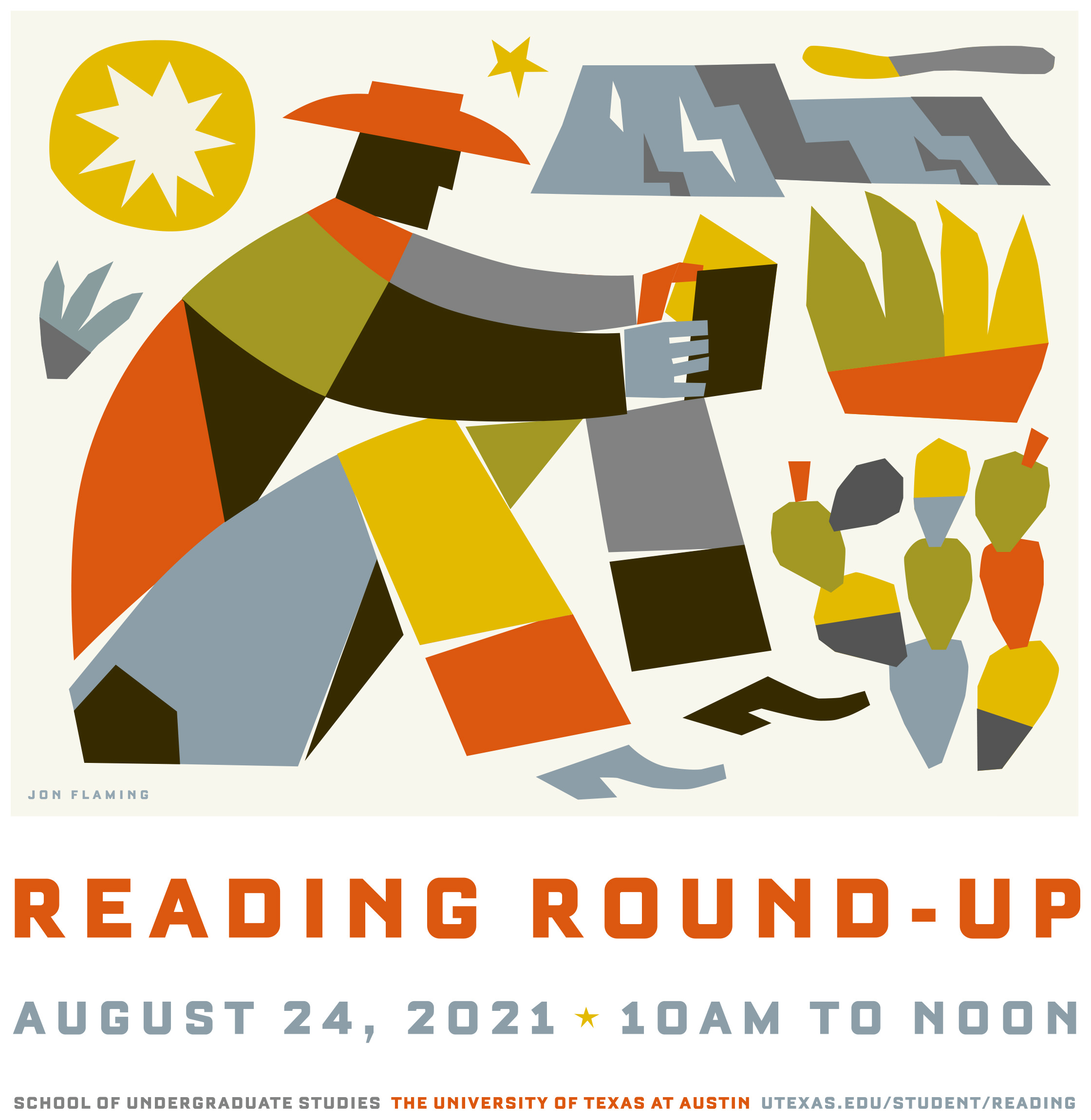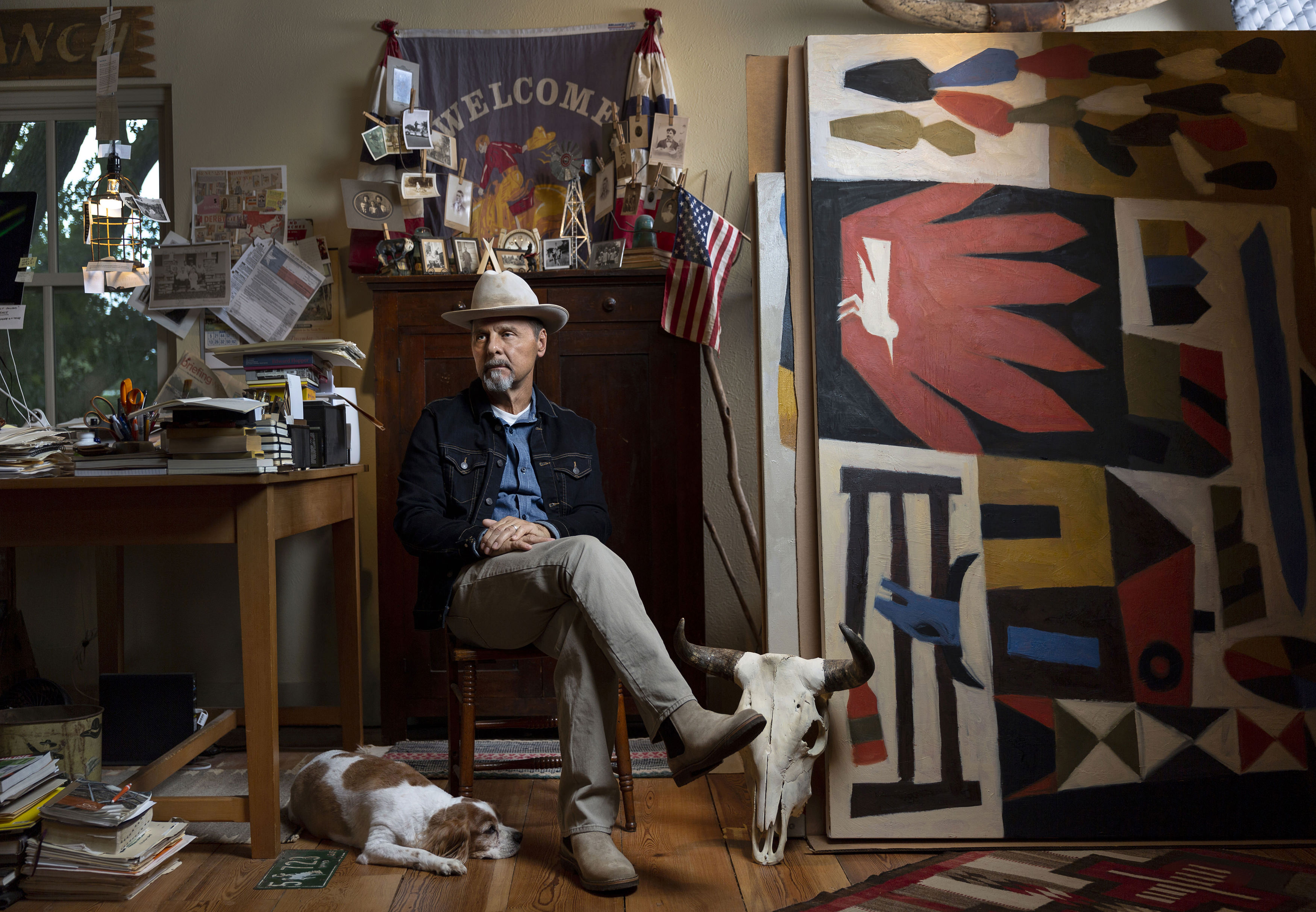Every year, the School of Undergraduate Studies commissions artwork for its annual Reading Round-Up program. This year’s art was created by Jon Flaming.
How did you get started as an artist? Is this a talent you’ve been developing your whole life, or did you find art later on?

I was five. We lived in Wichita, Kansas at the time. It was Sunday morning and in my little Sunday School class sat a kid next to me who could draw cool jet airplanes. I was fascinated by it and have been trying to draw cool jet airplanes ever since. Something about that moment has remained with me to this day. It sparked something creative in me that has never gone away.
My earliest and fondest memories are of my grandparent’s ranch/farm in southeast Kansas. It was a magical place for a little guy. 2000 acres of cattle, crops, tanks, fields, barbed wire, cactus, cedars, gravel roads, old houses, tractors, pickup trucks, barns, coyotes. Nighttime was special too—I could see every star, smell every smell from the grassy land, hear the train in the distance as it made its way through Altoona (the town to the east), hear the coyote and the owl. The old ranch house sat on a hill and the room where I slept was actually a closed-in porch that overlooked the fields to the east where my grandpa grew corn. I remember looking out over the field and imagining what this place was like 100 or more years ago and what my ancestors experienced on this land. During the day, I would roam the fields and play in the old rusted trucks and tractors in the “boneyard” (the place to the west of the old house where all the worn-out farm equipment was placed to rest). When I was old enough to drive, I would head into the nearby town of Fredonia and drive the streets around the square snapping photos and looking for inspiration. All of this and much more affected me deeply and to this day I have a very strong connection to the land and the working man. We moved to Texas in 1967 and I’ve been in love with it ever since.
I was an average student in high school, but I loved sports and I loved drawing. I played football all the way through high school but knew that would come to an end my senior year. Art was something I could pursue indefinitely. I went to Southwest Texas State (Texas State) and studied design, advertising, and illustration. I never took any fine art classes. After college, I came back to Dallas and went to work for Sullivan Perkins—a design studio that specialized in branding. I worked there for eight years learning everything I could about the business and in 1993, I opened my own design studio. My first client was Neiman Marcus. I also worked with American Airlines, Sony, FedEx, HP, and many more. I did this for 25 years.
As a kid, I loved watching the old black and white western shows like Fury, Rifleman, The Lone Ranger. I loved pretending that I was a cowboy and played “Cowboys & Indians” with my friends in the yard and in the woods behind our house. I keep coming back to the west because it keeps coming back to me. There is something romantic, mysterious, and dangerous about the west that folks around the world have been fascinated with for centuries. I continue to be fascinated by it because, in the west, anything is possible.
From the early days of spending time on my grandpa’s ranch to a suburban kid watching westerns and playing pretend to numerous trips to Big Bend, Terlingua, and other remote places in Texas, the west has burrowed itself deep into my being and has become an integral part of who I am and how I express myself.
(Interesting side note, Jon’s birthplace may have been Kansas, but his Texas connection is evidenced by the fact that his distant midwestern relative U.S. Senator Charles B. Farwell was responsible for financing the Texas State Capital in the late 1800s. He also owned the 3,000,000 acre XIT ranch in the Texas Panhandle with his brother John V. Farwell. Farwell is his mom’s maiden name.)
Your work has several distinct styles. Can you give us some insight into how you chose a style for this year’s Reading Round-Up artwork?
My most recent series is called “Modern Cowboy.” From the early Texas modernists like Everett Spruce and William Lester to the European masters like Cezanne, Matisse, Picasso to Stuart Davis and Marsden Hartley to designers like Paul Rand and Saul Bass, my influences are many. My style calls to mind primitive, outsider, folk, modern, contemporary and naive. My goal with Modern Cowboy is to re-imagine the western art genre—to meld my influences and push the boundaries of what traditionalists say is acceptable in western art. My heroes of the genre are Remington, Russell, Dixon, Dunton, and others. Their work is wonderful and I stand squarely on their shoulders, but I have no desire to copy their work or follow in their footsteps—that beautiful horse has already been ridden. I want to ride a fresh horse and blaze my own trail. I am creating large canvases with larger-than-life characters that speak of a state that is big and bold. I say, enough with the ordinary. On with the heroic.
As a kid, I loved to play make-believe. I could be anybody I wanted – a pilot, a fireman, an astronaut. I’m still doing that. Currently, I’m a cowboy.
What advice could you give for a student interested in art?
If you are passionate about creating, then throw your whole self in. Learn all you can about the different creative disciplines. Learn all the rules so that you will know what rules you are breaking when you’re ready to break the rules. Study the artists you admire. Copy them, but don’t claim the work for your own. Copy them so that you know how they work and think. Then go and develop your own style and voice so that others can copy you and then create their own look. Buy the best tools that you can afford and then start. If you can’t afford art supplies, be creative. Build something out of a discarded cardboard box. Make a collage out of pictures from a magazine. Arrange rocks you find in your garden. Do a pencil sketch. Do something. Don’t wait until you’re ready to get started. Just start. Someone once said, “Inspiration exists, but it must find you working.” By doing the work, you will open up all sorts of possibilities that wouldn’t be there otherwise. And by doing the work, your subconscious mind will fill in the blanks and you will surprise yourself with all the wonderful ideas you have.
Tell us about a recent read you enjoyed.
Boom: Mad Money, Mega Dealers and the Rise of Contemporary Art by Michael Shnayerson. Great read. I’m going through it again for the third time.

Portrait of Jon Flaming by Justin Clemons

